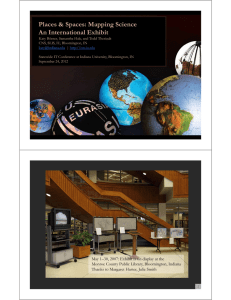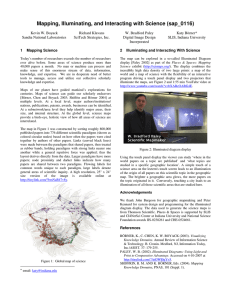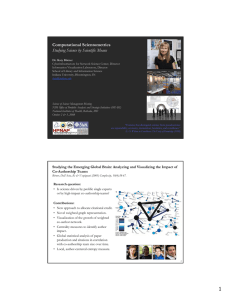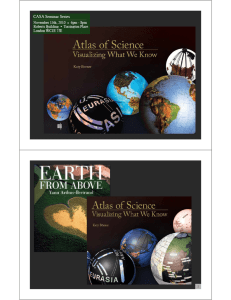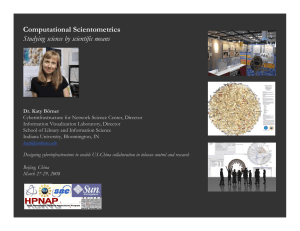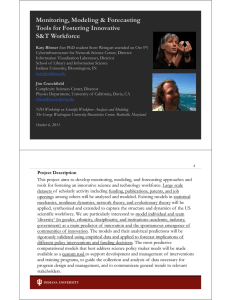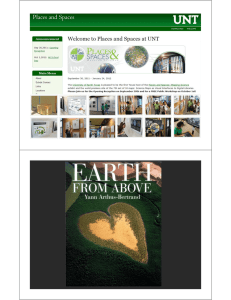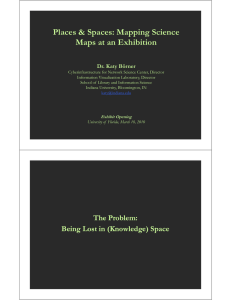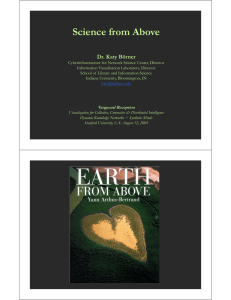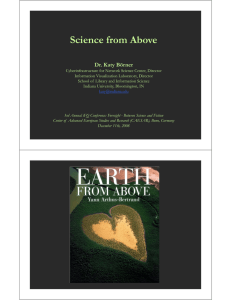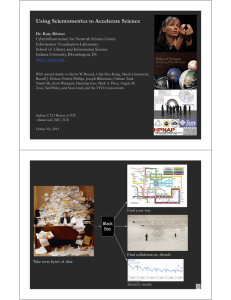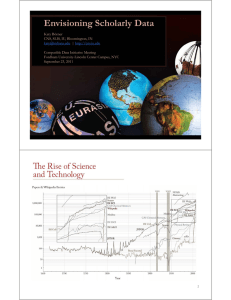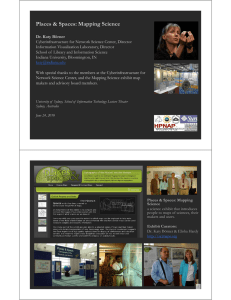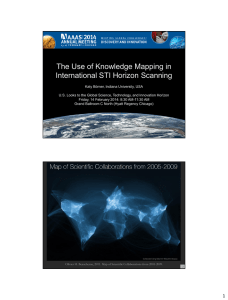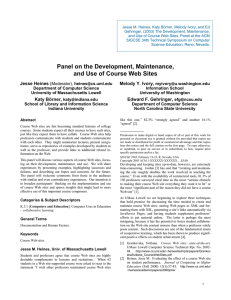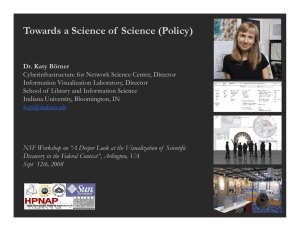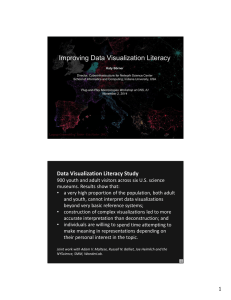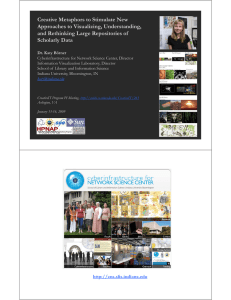Mapping Science and Technology Activity in Geospatial and Topical Spaces
advertisement
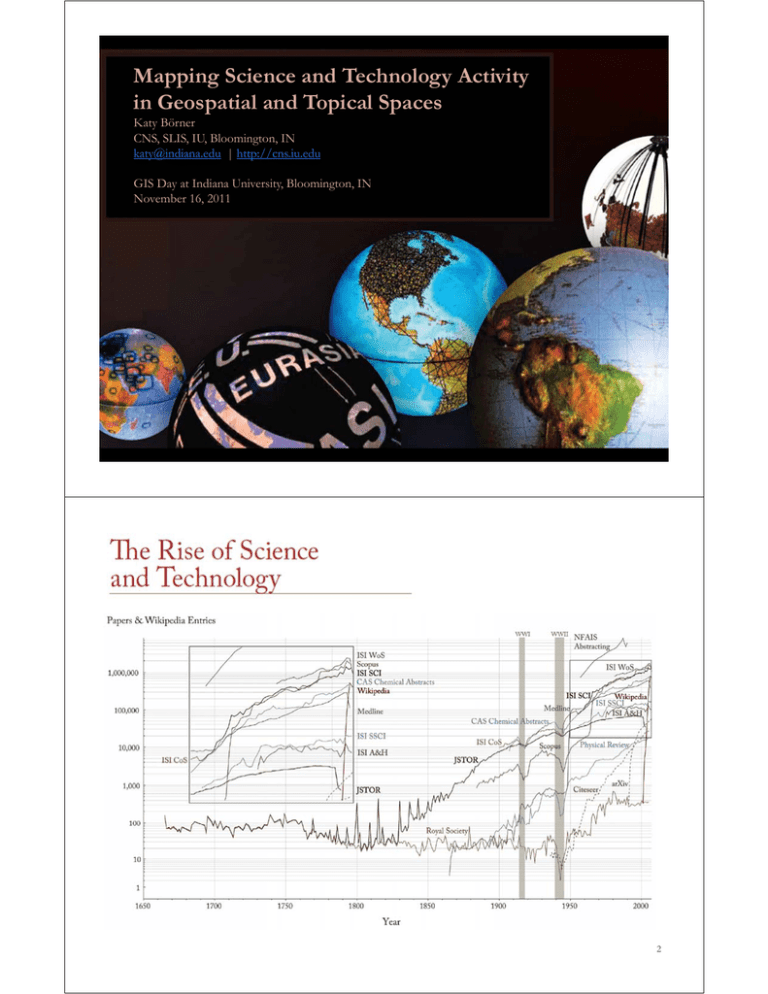
Mapping Science and Technology Activity in Geospatial and Topical Spaces Katy Börner CNS, SLIS, IU, Bloomington, IN katy@indiana.edu | http://cns.iu.edu GIS Day at Indiana University, Bloomington, IN November 16, 2011 2 3 4 2000 Night on Earth This image shows city lights at night. It was composed from hundreds of pictures made by orbiting satellites. The seaboards of Europe, the eastern United States, and Japan are particularly well lit. Many cities exist near rivers or oceans so that goods can be exchanged cheaply by boat. The central parts of South America, Africa, Asia, and Australia are rather dark despite their high population density, see map to the left. 5 2005 World Population The population map uses a quarter degree box resolution. Boxes with zero people are given in white. Darker shades of red indicate higher population counts per box using a logarithmic interpolation. The highest density boxes appear in Mumbai, with 11,687,850 people in the quarter degree block, Calcutta (10,816,010), and Shanghai (8,628,088). 6 2007 IP Address Ownership This map shows IP address ownership by location. Each owner is represented by a circle and the area size of the circle corresponds to the number of IP addresses owned. The larges circle denotes MIT’s holdings of an entire class A subnet, which equates to 16,581,375 IP addresses. The countries that own the most IP addresses are US (560 million), Japan (130 million), Great Britain (47 million). 7 2003 Scientific Productivity Shown is where science is performed today. Each circle indicates a geographic location at which scholarly papers are published. The larger the circle the more papers are produced. Boston, MA, London, England, and New York, NY are the top three paper production areas. Note the strong resemblance with the Night on Earth and the IP Ownership maps and the striking differences to the world population map. 8 Find your way Black Box Find collaborators, friends Take terra bytes of data Identify trends Early Maps of the World VERSUS 3D Physically-based Accuracy is measurable Trade-offs have more to do with granularity 2-D projections are very accurate at local levels Centuries of experience Geo-maps can be a template for other data 9 Early Maps of Science n-D Abstract space Accuracy is difficult Trade-offs indirectly affect accuracy 2-D projections neglect a great deal of data Decades of experience Science maps can be a template for other data Kevin W. Boyack, UCGIS Summer Meeting, June, 2009 10 … … … 11 Legal Citation Index, 1873 Citation Indexes for Science, 1955 Google, 1998 12 1934 2007 13 14 15 16 22 27 33 Illuminated Diagram Display W. Bradford Paley, Kevin W. Boyack, Richard Kalvans, and Katy Börner (2007) Mapping, Illuminating, and Interacting with Science. SIGGRAPH 2007. Questions: Who is doing research on what topic and where? What is the ‘footprint’ of interdisciplinary research fields? What impact have scientists? Large-scale, high resolution prints illuminated via projector or screen. Interactive touch panel. Contributions: Interactive, high resolution interface to access and make sense of data about scholarly activity. 34 35 36 Science Maps in “Expedition Zukunft” science train visiting 62 cities in 7 months 12 coaches, 300 m long Opening was on April 23rd, 2009 by German Chancellor Merkel http://www.expedition-zukunft.de 37 38 39 40 41 Science Puzzle Map for Kids by Fileve Palmer, Julie Smith, Elisha Hardy and Katy Börner, Indiana University, 2006. (Base map taken from Illuminated Diagram display by Kevin Boyack, Richard Klavans, and W. Bradford Paley.) 42 43 44 Mapping Science Exhibit – 10 Iterations in 10 years http://scimaps.org/ The Power of Maps (2005) Science Maps for Economic Decision Makers (2008) The Power of Reference Systems (2006) Science Maps for Science Policy Makers (2009) The Power of Forecasts (2007) Science Maps for Scholars (2010) Science Maps as Visual Interfaces to Digital Libraries (2011) Science Maps for Kids (2012) Science Forecasts (2013) How to Lie with Science Maps (2014) Exhibit has been shown in 72 venues on four continents. Currently at - NSF, 10th Floor, 4201 Wilson Boulevard, Arlington, VA - Center of Advanced European Studies and Research, Bonn, Germany - Science Train, Germany - Cultural Dimensions of Innovation, UCD Conference, Dublin, Ireland 45 Debut of 5th Iteration of Mapping Science Exhibit at MEDIA X was on May 18, 2009 at Wallenberg Hall, Stanford University, http://mediax.stanford.edu, http://scaleindependentthought.typepad.com/photos/scimaps 46 Science Maps for Economic Decision Making Four Existing Maps VERSUS Six Science Maps (4th Iteration of Places & Spaces Exhibit - 2008) Joseph Minard, Title: Europe Raw Cotton Imports in 1858, 1864 and 1865 (1866) What insight needs to economic decision makers have? What data views are most useful? Science Maps for Science Policy Making Four Existing Maps VERSUS Six Science Maps (5th Iteration of Places & Spaces Exhibit - 2009) Bollen, Johan, Herbert Van de Sompel, Aric Hagberg, Luis M.A. Bettencourt, Ryan Chute, Marko A. Rodriquez, Lyudmila Balakireva. 2008. A Clickstream Map of Science. 56 Council for Chemical Research. 2009. Chemical R&D Powers the U.S. Innovation Engine. Washington, DC. Courtesy of the Council for Chemical Research. 57 Science Maps for Scholars Four Existing Maps VERSUS Six Science Maps (6th Iteration of Places & Spaces Exhibit – 2010) John A. Walsh, Devin Becker, Bradford Demarest, Jonathan Tweedy, Theodora Michaelidou, and Laura Pence (2010) Map of Literary Empires: Mapping Temporal and Spatial Settings of Victorian Poetry. 60 Loet Leydesdorff, Thomas Schank and the Journal of the American Society for Information Science and Technology. 2010. The Emergence of Nanoscience & Technology. Science Maps as Visual Interfaces to Digital Libraries Four Existing Maps VERSUS Six Science Maps (7th Iteration of Places & Spaces Exhibit – 2011) 61 Paul Otlet (1936/37) Mondothèque. Multimedia Desk in a Global Internet. H.J.T. Ellingham (1948) A Chart Illustrating Some of the Relations between the Branches of Natural Science and Technology. Almila Akdag Salah, Cheng Gao, Krzysztof Suchecki, and Andrea Scharnhorst (2011) Design vs. Emergence: Visualization of Knowledge Orders. Ward Shelley. 2011. History of Science Fiction. We would like to thank the map makers Computational Scientometrics Cyberinfrastructures Börner, Katy. (2011). Plug-and-Play Macroscopes. Communications of the ACM, 54(3), 60-69. Scholarly Database: 25 million scholarly records http://sdb.slis.indiana.edu VIVO Research Networking http://vivoweb.org Network Workbench Tool & Community Wiki http://nwb.cns.iu.edu Science of Science (Sci2) Tool http://sci2.cns.iu.edu Epidemics Cyberinfrastructure http://epic.cns.iu.edu 68 References Börner, Katy, Chen, Chaomei, and Boyack, Kevin. (2003). Visualizing Knowledge Domains. In Blaise Cronin (Ed.), ARIST, Medford, NJ: Information Today, Volume 37, Chapter 5, pp. 179-255. http://ivl.slis.indiana.edu/km/pub/2003-borner-arist.pdf Shiffrin, Richard M. and Börner, Katy (Eds.) (2004). Mapping Knowledge Domains. Proceedings of the National Academy of Sciences of the United States of America, 101(Suppl_1). http://www.pnas.org/content/vol101/suppl_1/ Börner, Katy, Sanyal, Soma and Vespignani, Alessandro (2007). Network Science. In Blaise Cronin (Ed.), ARIST, Information Today, Inc., Volume 41, Chapter 12, pp. 537607. http://ivl.slis.indiana.edu/km/pub/2007-borner-arist.pdf Börner, Katy (2010) Atlas of Science. MIT Press. http://scimaps.org/atlas Scharnhorst, Andrea, Börner, Katy, van den Besselaar, Peter (2011) Models of Science Dynamics. Springer Verlag. 69 All papers, maps, tools, talks, press are linked from http://cns.iu.edu CNS Facebook: http://www.facebook.com/cnscenter Mapping Science Exhibit Facebook: http://www.facebook.com/mappingscience
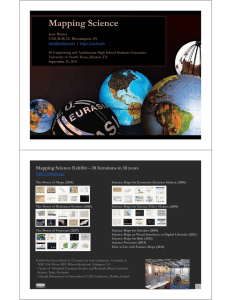
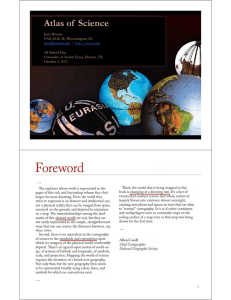
![Science Maps Explore New Ways of Displaying Information [Slide Show]](http://s2.studylib.net/store/data/010768709_1-3220b04c018450634153c8bae5b4b731-300x300.png)
